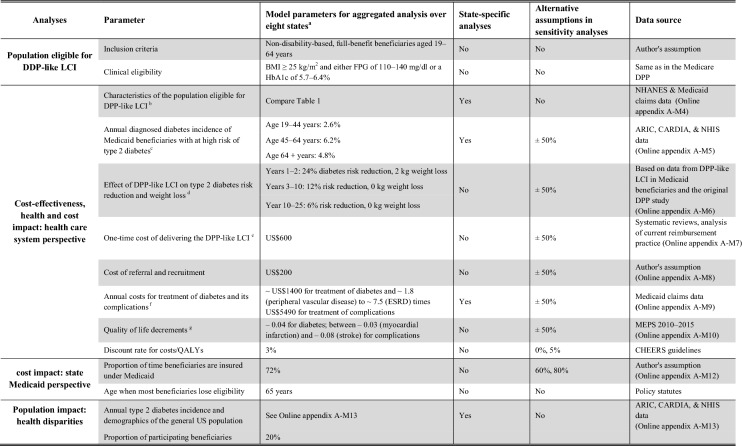Table 1.
Summary of relevant model assumptions
DPP Diabetes Prevention Program, LCI lifestyle change intervention, ESRD end-stage renal disease, FPG fasting plasma glucose, HbA1c hemoglobin A1c, BMI body mass index, NHANES National Health and Nutrition Examination Survey, NHIS National Health Interview Survey ARIC Atherosclerosis Risk in Communities Study; CARDIA Coronary Artery Risk Development in Young Adults Study, MEPS Medical Expenditure Panel Survey, QALYs quality adjusted life years
aAlabama, California, Connecticut, Florida, Iowa, Illinois, New York, and Oklahoma; bPopulation characteristics of the Medicaid population at high risk for type 2 diabetes were derived by matching individual-level Medicaid claims with data from NHANES; cIncidence of type 2 diabetes in this population was directly estimated from the NHIS, the ARIC Study, and the CARDIA Study; dPre–after DPP-like LCI weight-loss data from studies in the Medicaid population [18, 35] were combined with data on weight loss and type 2 diabetes incidence reduction from the original DPP and other RCTs [7, 41] to infer the expected diabetes incidence reduction that results from the intervention; dCosts of delivering DPP-like LCI are based on cost estimates from previous studies and on current reimbursement practices [22, 54]; eCosts for treatment of diabetes and diabetic complications were directly estimated from Medicaid claims data from the states of Alabama, California, Connecticut, Florida, Iowa, Illinois, New York, and Oklahoma; fQuality of life decrements were directly estimated from data from the Medical Panel Expenditure Surveys (MEPS)

